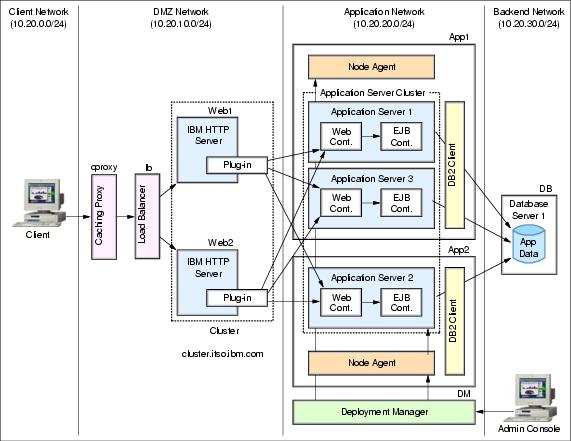The sample topology
We started our discussion on topologies with a single server configuration where all components reside on the same machine. Now we introduce a sample configuration that explores the subjects discussed so far:
| Separating the HTTP server |
| Separating the database |
| Vertical scaling |
| Horizontal scaling |
| HTTP server clustering |
To configure, test, and evaluate the behavior of several components, we set up the configuration illustrated in Figure 3-14 and used it throughout this book to test and evaluate aspects of IBM WAS V5.1 scalability. Chapter 7, Implementing the sample topology, describes the steps to set up this sample configuration.
The resulting topology is composed of:
Important: To make it easier to demonstrate the workload management and failover capabilities of WebSphere we have chosen to split the Web container and the EJB container in our sample topology. As mentioned earlier, while this is a possible configuration, however, it is not recommended because doing so will most likely have a negative impact on the performance. This as a result of the out of process calls from the EJB clients in the Web container to the EJB container. |

Figure 3-14 ITSO sample topology
We have two HTTP servers configured as a cluster under the control of WebSphere Load Balancer. The HTTP servers are configured to respond both to port 80 (HTTP) and port 443 (HTTPS). The plug-in configuration file (plugin-cfg.xml) must be copied to both servers. The Load Balancer server distributes requests among the HTTP servers based on weights set by the Load Balancer's manager component.
As well as monitoring the network reachability of the machines, an HTTP advisor is activated to poll the availability of the HTTP service on each machine.
WebSphere is a trademark of the IBM Corporation in the United States, other countries, or both.
IBM is a trademark of the IBM Corporation in the United States, other countries, or both.